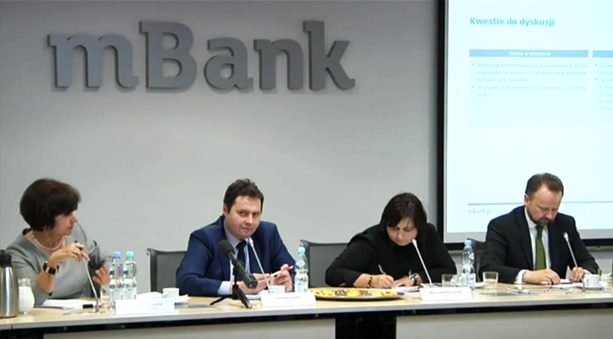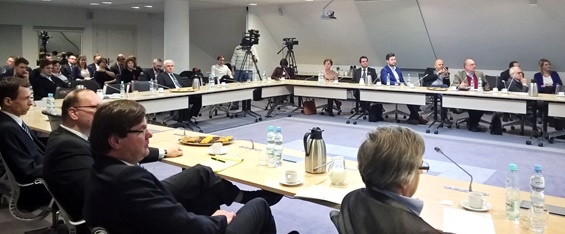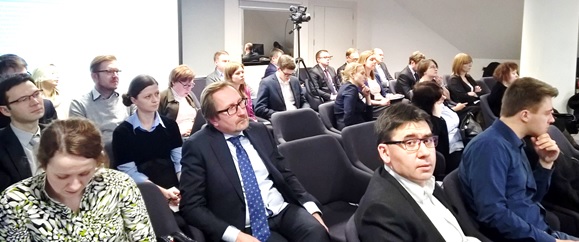Corporate debt securities market in Poland: state of art, problems, and prospects for development
 The development of the Polish corporate bonds market resulted from changes on the supply side. When the Lehman Brothers went bankrupt, Polish entrepreneurs realized that financing their companies’ operations only with the use of credit, even if contracted from different sources, might not be the best idea. Consequently, Polish business turned to debt instruments – said Piotr Kowalski, Head of the Warsaw Office of Fitch Ratings, the first of our keynote speakers at the 136th mBank-CASE Seminar “Corporate debt securities market in Poland: state of art, problems, and prospects for development” which took place on the 5th of March 2015. During the seminar, presentations were also delivered by Agnieszka Gontarek, Director of the Cash Market Department at the Warsaw Stock Exchange and Tomasz Gałka, Director of Debt Capital Markets at mBank S.A.
The development of the Polish corporate bonds market resulted from changes on the supply side. When the Lehman Brothers went bankrupt, Polish entrepreneurs realized that financing their companies’ operations only with the use of credit, even if contracted from different sources, might not be the best idea. Consequently, Polish business turned to debt instruments – said Piotr Kowalski, Head of the Warsaw Office of Fitch Ratings, the first of our keynote speakers at the 136th mBank-CASE Seminar “Corporate debt securities market in Poland: state of art, problems, and prospects for development” which took place on the 5th of March 2015. During the seminar, presentations were also delivered by Agnieszka Gontarek, Director of the Cash Market Department at the Warsaw Stock Exchange and Tomasz Gałka, Director of Debt Capital Markets at mBank S.A.
As Piotr Kowalski pointed out, the non-governmental bond market was created in Poland only 18 years ago, which means it still needs to become truly mature. According to him, during the very first years of its operation, short-term debt instruments were the most popular. Later, they gave way to bonds issued by corporations and banks (their market shares are 38 and 35% respectively). The first significant flotations, which generated interest of the public opinion, took place last year - the bonds were issued by companies operating in the energy sector. In 2014, the total value of instruments floating in Poland amounted to about 21.3 bln PLN. Although the market has been rapidly growing in recent years, it still considerably differs from the Western European markets, which are mainly dominated by the institutional players (investment and pension funds). As Piotr Kowalski emphasized, the situation on the Polish market is shaped primarily by banks, which are flotations’ organizers and guarantors, as well as by enterprises, which treat corporate bond as a kind of deposit, which is almost equally safe but yields slightly higher profits. Discrepancies are also noticeable in terms of maturity – in the case of bonds issued in Western countries, they need 5-7 years, whereas they only need 3 years in Poland.
 Agnieszka Gontarek presented the mechanisms and characteristics of the ‘Catalyst’ market. As she explained, its creation in September 2009 was preceded by a huge debate about its pros and cons. Many experts maintained that the corporate bond market should be reserved to banks and not to the Warsaw Stock Exchange. Yet, the arguments for Catalyst were the ones who won. Among the advantages of the solution, Agnieszka Gontarek evoked better access to bonds on the secondary market (if investors wish to cash their bonds they do not have to wait until the maturity date), flotation standardization, which improves the issuer reliability and creditworthiness, and quotation on the organized market, which is always better than the one on the OTC market.
Agnieszka Gontarek presented the mechanisms and characteristics of the ‘Catalyst’ market. As she explained, its creation in September 2009 was preceded by a huge debate about its pros and cons. Many experts maintained that the corporate bond market should be reserved to banks and not to the Warsaw Stock Exchange. Yet, the arguments for Catalyst were the ones who won. Among the advantages of the solution, Agnieszka Gontarek evoked better access to bonds on the secondary market (if investors wish to cash their bonds they do not have to wait until the maturity date), flotation standardization, which improves the issuer reliability and creditworthiness, and quotation on the organized market, which is always better than the one on the OTC market.
Bonds on the Catalyst market are traded on two transaction platforms: the Warsaw Stock Exchange platform and the BondSpot platform (entity owned by WSE), which both operate in the form of regulated markets and alternative trading systems (ASO). The WSE platform is dedicated to retail investors, while BondSpot is devoted to wholesale investors. Since its creation, the number of Catalyst’s issuers and flotation series have increased significantly. In 2009, there were only 18 issuers and 47 flotation series, while 5 years later the number of entities and flotation series reached 196 and 526, respectively. According to Agnieszka Gontarek, this data shows Catalyst’s success.
 During the lively debate that ensued after the presentations, our guests discussed the perspectives of development in the sector and the main problems of its operations – we encourage you to watch the entire Seminar online on bankier.tv.
During the lively debate that ensued after the presentations, our guests discussed the perspectives of development in the sector and the main problems of its operations – we encourage you to watch the entire Seminar online on bankier.tv.
WATCH THE VIDEO OF THE SEMINAR ONLINE

